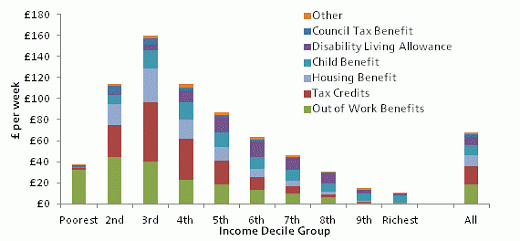In his speech to the Conservative party conference today, the Chancellor of the Exchequer again stated an intention to reduce welfare expenditure by a further £10 billion per year by 2016–17.
Given the £18 billion per year of welfare cuts already planned by 2014–15, total welfare spending in that year is currently forecast to be £214 billion. Of that, £94 billion will be spent on state pensions and Pension Credit. If these are protected from cuts, the additional £10 billion of savings would have to be found from the remaining £120 billion of welfare spending: a cut of 8.3% in that part of the budget. The figure below illustrates who is currently entitled to these benefits and tax credits, showing average entitlements for families in each decile group of the working-age income distribution. It shows that approximately ¾ of the entitlements go to the lowest-income half of working-age families, and ¼ to the top half (note that Child Benefit is already set to be withdrawn from families containing an individual with annual taxable income exceeding £50,000 from January 2013, which will reduce the fraction of welfare entitlements going to higher-income families).
Figure: Average weekly entitlements to benefits and tax credits among working-age families in 2012–13

Note: Income decile groups are derived by dividing all families into 10 equal-sized groups according to income adjusted for household size using the McClements equivalence scale. Decile group 1 contains the poorest tenth of the population, decile group 2 the second poorest, and so on up to decile group 10, which contains the richest tenth.
Source: Authors’ calculations using 2009–10 Family Resources Survey and TAXBEN, the IFS’ tax and benefit micro-simulation model.
One simple way of reducing welfare expenditure would be not to go ahead with the usual indexation of benefits in line with prices next April. The Chancellor asked “how can we justify the incomes of those out of work rising faster than the incomes of those in work?” A freeze for all working-age benefits and tax credits would save around £2 billion per year. But the Chancellor’s comments might suggest that this would only apply to out-of-work benefits (Jobseeker’s Allowance, Employment and Support Allowance and Income Support), which would – as the figure makes clear – substantially reduce the potential savings.
The Prime Minister and the Chancellor have mentioned two other specific areas where they believe the current benefit system is too generous. The first is Housing Benefit for the under 25s, who comprise almost 400,000 (8%) of the 5 million Housing Benefit claimants. Abolition of Housing Benefit for this group would save nearly £2 billion per year. Realistically though, it seems highly likely that some of the group will be made exempt from this cut. A crucial issue here is how the government would distinguish between those who can and cannot reasonably be expected to live with their parents. For example, more than half of Housing Benefit spending on under-25s goes to individuals who themselves have dependent children: might the government include them in the group who could reasonably be expected to live with parents? The answers to these kinds of questions will determine how much less than £2 billion per year the government would save from this policy, and how workable it would be in practice.
The second area that has been highlighted is state support for large out-of-work families. We have argued previously that this principle seemed implicit in an existing government policy: the overall household benefits cap, to be introduced in April 2013, will in practice only affect families with large numbers of children and/or high housing costs. If the government believes that these families are currently entitled to too much, it is better to be explicit about that when designing welfare policy so that the perceived problem is targeted as precisely as possible, rather than addressing it indirectly via an overall cap on benefits. In terms of the revenue consequences, though, this does not get us to £10 billion per year of welfare cuts. About 330,000 out-of-work families have at least three children, meaning that to save £1 billion a year would require entitlements to be cut by an average of £3,000 per family for this group.
As always, then, there are all sorts of tradeoffs and issues to think about when designing welfare policy. It is clear, however, that there is more we have yet to hear about if the government is to cut the welfare budget by an additional £10 billion per year.









